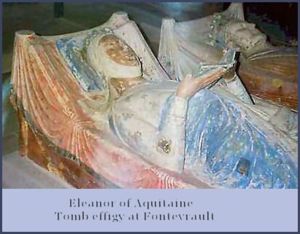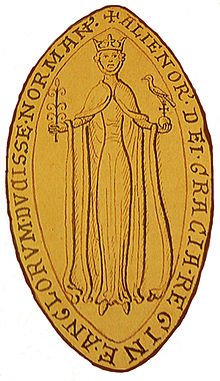| Eleanor (Aquitaine) of Aquitaine is managed by the Medieval Project. Pre-1500 certified? Join: Medieval Project Discuss: Medieval |
Contents |
Biography
Eleanor of Aquitaine (Aliénor/Aénor d'Aquitaine in French, Alienora in Latin) was Duchess of Aquitaine, Queen Consort of France from 1137 to 1152, and Queen Consort of England from 1154 to 1189.[1]
Birth and Parents
Eleanor was the older daughter of Guillaume d'Aquitaine and Aliénor/Aénor de Châtellerault. She was probably born in 1122-1124.[1] Her place of birth is uncertain: places that have been suggested are Nieul-sur-Autize in the Vendée,[2] the Château de Belin in Guyenne (part of Aquitaine) and the Palais d’Ombrière, Bordeaux (also in Aquitaine).[3] She is named as daughter of Guillaume and Aliénor/Aénor in a charter of 1130.[3]
Inheritance
Eleanor's father died in 1137, leaving her heir to vast parts of the France, centred on the Duchy of Aquitaine (she became Duchess in her own right). She also had a claim on the County of Toulouse, which both her husbands attempted to make good.[1]
Queen Consort of France
In late July 1137), in the Cathedral of Bordeaux, Eleanor was married to Louis VII, who had been crowned French king in 1131, in his father's lifetime.[1] There is some slight disagreement about the exact date of their marriage. Charles Cawley's Medieval Lands gives it as 22 July.[3] Both the English and French versions of Wikipedia cite modern historians giving the date as 25 July.[4] They had two daughters, whose husbands were brothers:
- Marie, born in about 1145, who married Henri, 1st Count of Champagne[2][1]
- Alix, born in about 1150, who married Thibaut, Count of Blois[2][1]
The marriage brought large parts of France within the more direct control of the French crown. The importance of this is demonstrated by Louis being styled "rex Francorum et dux Aquitanorum" - "king of the French and Duke of the people of Aquitaine".[1]
On 11 June 1147 Eleanor and Louis VII set off from Vézélay to participate in the ineffectual Second Crusade. Eleanor's uncle Raymond of Poitiers, Prince of Antioch, wanted the crusaders to help besiege Aleppo, but Louis declined. This led, or contributed, to friction between Eleanor and Louis.[1]
When Eleanor and Louis sailed back to France in separate ships. She was captured by a Greek but soon rescued, and rejoined her husband: they received a warm reception in Sicily in September 1149. In October, they visited the Pope, who, it is said, was keen to foster good relations between them. But reconciliation did not last, and on 11 March 1152 their marriage was formally dissolved at the castle of Beaugency, the official reason being consanguinity.[1]
Marriage to Henry II of England
This left Eleanor, with her substantial possessions, a very desirable marriage prospect. Within weeks of the dissolution of her first marriage, she married the future Henry II, on 18 May 1152 at either Poitiers Cathedral[1][5] or Bordeaux Cathedral.[6][3] (The Oxford Dictionary of National Biography entry for Henry II does not give a marriage place.[7]) The marriage created what is often known as the Angevin Empire, covering England, part of Ireland and large parts of France, and made Henry II one of the most powerful rulers in Europe.
Eleanor was crowned Queen of England at Westminster Abbey on 19 December 1154.[1]
Children of her second Marriage
- William, born in Normandy on 17 August 1153, died at Wallingford, Berkshire about 15 December 1156[6]
- Henry, known as the Young King, born at Bermondsey, Surrey on 28 February 1155, died in Touraine on 11 June 1183 and was buried in Rouen Cathedral, Normandy[6]
- Maud/Matilda, born in 1156, married Henry the Lion, died at Braunschweig (Brunswick), Germany on 28 June 1189[6]
- Richard, who became King Richard I, born at Oxford, Oxfordshire on 8 September 1157[6]
- Geoffrey, born on 23 September 1158[6]
- Eleanor, born at Domfront, Normandy on 13 October 1162, married Alfonso VIII of Castile, died at Burgos, Spain on 25 October 1214[8]
- Joan, born at Angers, Anjou in October 1165, married William II of Sicily and Raymond VI of Toulouse, died on 24 September 1199[6]
- John, born at Oxford, Oxford on 24 December 1166, who succeeded his brother Richard as King of England [6]
Reign of Henry II
For some years Eleanor played an active role in the administration of both Aquitaine and England. In 1168 she was in Poitou with her son Richard and Patrick, 1st Earl of Salisbury. Patrick was killed in an affray with local barons, and, according to a later account, Eleanor herself came close to being captured and was saved by William Marshal. The next year Richard paid homage to Louis VII for the Duchy of Aquitaine, suggesting that it had been formally vested in him by his parents, but, given that he was only 12, his mother is likely to have taken a leading part in the governance of the Duchy.[1]
In 1173 her children Henry, Richard and Geoffrey rebelled against their father, with Eleanor Backing, and possibly inciting, them. Allegedly disguised as a man, she was seized by supporters of Henry II and taken to England where she was held prisoner for ten years or more. In 1183 her son Henry, just before his death, urged that the conditions of her confinement be relaxed, and this seems to have happened: the next year she met her daughter Matilda and Matilda's husband Henry the Lion when they visited England, with expensive new clothing being ordered for her. In 1185 Henry II ordered their son Richard to hand over to her formal governance of Poitou.[1]
Reign of Richard I
When Richard I came to the throne in 1189, one of his first acts was to set Eleanor free. He restored lands she had held before the 1173 rebellion, and gave her extensive power in England. In 1190-1 she escorted Richard I's wife-to-be Berengaria of Navarre to Messina, Sicily. When Richard was captured by the Duke of Austria as he was returning from crusade and held prisoner, Eleanor corresponded with him about English affairs, took a major role in negotiations for his release, and made an extended visit to Germany. She facilitated reconciliation between Richard and his brother, the future King John, who had engaged in rebellion during Richard's absence. After this she sought retirement in the Abbey of Fontevraud.[1]
Reign of John
The accession of her son John to the throne in 1199 brought her out of retirement, though her focus was on French, not English affairs. She helped to secure for John the support of the barons of Poitou. That year she paid homage in her own right to Philippe Auguste, King of France, for Poitou. This was part of a set of arrangements designed to safeguard John's right to inherit Poitou and to counter claims on Aquitaine and Poitou of her grandson Arthur of Brittany. Now well into her seventies, she found herself involved in military action against Arthur: she oversaw the sacking of the region around Angers. In July 1202 she was besieged by Arthur's forces in Mirebeau, Poitou: King John came to her aid, relieving the town and capturing Arthur.[1]
Patronage of Literature
Eleanor was a significant patron of literature. She attracted troubadours like [Bernart de Ventadorn Bernart de Ventadorn/Bernard de Ventadour] to her court, though suggestions that he was her lover should be discounted. She was one of the dedicatees of the Roman de Rou by Wace, an account in verse of the Dukes of Normandy. Unusually for this period, her funeral monument shows her holding an open book.[1]
Death and Burial
Eleanor died on 31 March 1204, either at Poitiers or at Fontevraud Abbey, Anjou. She was buried next to Henry II and Richard I at Fontevraud Abbey.[1]
Sources
- ↑ 1.00 1.01 1.02 1.03 1.04 1.05 1.06 1.07 1.08 1.09 1.10 1.11 1.12 1.13 1.14 1.15 1.16 Oxford Dictionary of National Biography, entry by Jane Martindale for 'Eleanor [Eleanor of Aquitaine], suo jure duchess of Aquitaine', print and online 2004
- ↑ 2.0 2.1 2.2 Douglas Richardson. Royal Ancestry: A Study in Colonial and Medieval Families, 5 vols, ed. Kimball G. Everingham (Salt Lake City: the author, 2013), Vol III, pp. 21-24, FRANCE 6
- ↑ 3.0 3.1 3.2 3.3 Charles Cawley. Medieval Lands: A Prosopography of Medieval European Noble and Royal Families, entry for 'ELEONORE d'Aquitaine', accessed 13 October 2023
- ↑ Eleanor of Aquitaine and Wikipédie, Aliénor d'Aquitaine
- ↑ Alison Weir. Britain's Royal Families, Vintage Books, 2008, p. 60
- ↑ 6.0 6.1 6.2 6.3 6.4 6.5 6.6 6.7 Douglas Richardson. Royal Ancestry: A Study in Colonial and Medieval Families, 5 vols, ed. Kimball G. Everingham (Salt Lake City: the author, 2013), Vol. I, pp. 24-43, ENGLAND 4
- ↑ Oxford Dictionary of National Biography, entry by Thomas K Keefe for 'Henry II', print and online 2004, revised online 2008
- ↑ Douglas Richardson, Royal Ancestry, Viol. II, pp. 114-115, CASTILE 5
See also:
- Dictionary of National Biography, 1885-1900, Vol. 17, pp. 175-178, entry for ' (Quaker 6th month)', Wikisource
- Andrews, J F. The Families of Eleanor of Aquitaine: A Female Network of Power in the Middle Ages, History Press, 2023
- Cockerill, Sara. Eleanor of Aquitaine: Queen of France and England, Mother of Empires, Amberley Publishing, 2019
- Duffy, Mark. Royal Tombs of Medieval England, History Press, 2003, pp. 57 and 60
- Weir, Alison. Eleanor of Aquitaine, Vintage Press, 2007 (paperback 2008)
- Eleanor of Aquitaine
- Wikipédie, Aliénor d'Aquitaine (article in French version of Wikipedia)
- Wikidata: Item Q178525, en:Wikipedia

No known carriers of Eleanor's DNA have taken a DNA test.
Have you taken a DNA test? If so, login to add it. If not, see our friends at Ancestry DNA.
- Is there a sticker for Elinor of Aquitaine Jun 3, 2022.
- Is Aliénor d'Aquitaine your ancestor? Jun 3, 2020.
- Will the Euro-Aristo 749-1499 project please give this profile some TLC? Apr 4, 2017.
Eleanor is 27 degrees from Emeril Lagasse, 27 degrees from Nigella Lawson, 27 degrees from Maggie Beer, 41 degrees from Mary Hunnings, 34 degrees from Joop Braakhekke, 32 degrees from Michael Chow, 29 degrees from Ree Drummond, 27 degrees from Paul Hollywood, 28 degrees from Matty Matheson, 30 degrees from Martha Stewart, 32 degrees from Danny Trejo and 33 degrees from Molly Yeh on our single family tree. Login to find your connection.
A > Aquitaine | O > of Aquitaine > Aliénor (Aquitaine) of Aquitaine
Categories: France, Featured Connections | Featured Royalty | House of Poitiers | House of Plantagenet | Second Crusade | This Day In History March 31 | This Day In History May 18 | This Day In History July 25 | Notables







edited by Michael Cayley